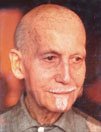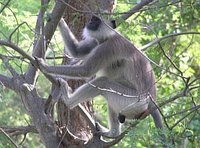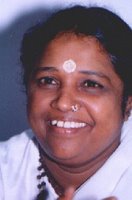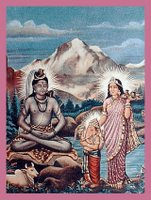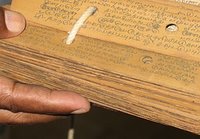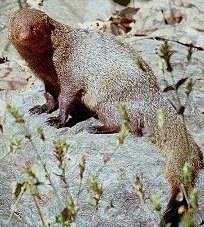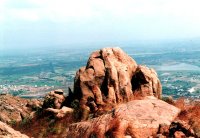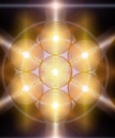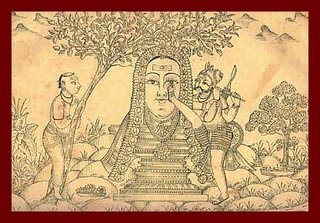
There is a Temple built at the foot of Arunachala, off the pradakshina route, on a rock dedicated to Sri Kannappar. Kannappar who was one of the sixty-three Nayanars (Tamil Poet-Saints) whose lives are recorded in the Periya Puranam (Lives of the Saints). The actual story of Kannappa Nayanar is supposed to have taken place at a Hill Temple in Sri Kalahasti, near Tirupathi.
The story goes that there was a forest place called Uduppur. It was an isolated area populated by fierce villagers. Nagan and Tatthai had a great desire for a child but as they were old had to go to a shrine of Lord Murugan to receive his blessings before they were able to conceive. A son was soon born to them who they named Thinnan (meaning strong), because he was so powerful and heavy that even his father could hardly hold him up.
When the boy reached 16 years of age, he took over the position of leader of the hunters. During a pig hunt, Thinnan and some companions had to go deep into the forest. It was there that the youth saw the hill of Lord Siva. Kindled by an unexplainable emotion he went towards the hill.
The culmination of austerities he did in previous births came to him and he proceeded towards the Lord. He saw Him and drank through his eyes the wonderful sight; It flowed over his heart; He lost all control and ran towards the Lingam to embrace and kiss the Diety.
Thinnan started performing service by bringing water from the river in his mouth and bathing the image of the Lord by emptying the water he carried in his mouth onto the Lingam. He would chew meat to ascertain its suitability before offering the choicest bits to his deity.
When he left for hunting, a sage came who was shocked at the sight of strewn bones and flesh in front of the Lord. After prostrating many times the sage cleaned the altar and performed his own puja before returning to his hermitage.
This continued for many days. To explain the love of his huntsman devotee, God appeared to the sage and told him, 'Don't think he is a scoundrel. His form is full of my love, his mind thinks of me only and his deeds are delightful for me. The water he spits on me is more sacred than Ganga, the flowers he offers taking from his head are holier than that are offered by Devas. It is all because of His love. You can see the excellence of his devotion tomorrow, if you hide and watch'.
It was the seventh day of Thinnans worship. When he arrived at the Lingam he was shocked to see that one eye of the Diety was bleeding. While worrying about his inability to find a solution, he remembered an old saying flesh for flesh. So, immediately Thinnan plucked out one of his own eyes with a sharp arrow and placed it onto the bleeding eye of the Lords. Thinnan jumped up and down in excitement when the bleeding from the Dietys eye stopped.
But as it stopped in the right eye, it started from the left. After a moment Thinnan told himself, 'I know the medicine. I have one more eye. That should cure this'. But when he was about to pluck out his remaining eye, he realised the difficulty of placing the eye in position once he took out his remaining eye. So he held his foot on the Dietys eye as a mark, and raised the arrow to take his remaining eye out.
The Lord Himself was not able to bear this great action, and appeared and holding the devotee's hands to stop him from plucking the remaining eye, called out:
'Oh halt Kann Appa, Kann Appa Since you gave your own eyes for me, you will be called Kannappan (the person who gave eyes to the Lord) hereafter.' And with that contact the devotee's sight was fully restored and the Lord pleased with his devotion granted him eternal bliss.
Although a hunter and meat-eater, Kannappar had such great devotion to Siva that he offered him his eyes. And in Guru Vachaka Kovai, verse 164, Sri Bhagavan gives the meaning of this story.
164
Kannappa, ripe in love, scooped out
And in the Lord's face planted his eyes.
But till he plucked and planted them
He too retained a trace of price
In those bright, beautiful orbs of his.
Attachment to the body dies
Hard, very hard indeed.
165
Why did the three-eyed Lord ordain
That Kanappa should pluck and plant
Those eyes of which he was so proud?
It was to save him from the death,
The deadly folly of deeming he
Was flesh inert. Such is the might
Of Siva.
